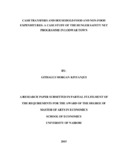| dc.description.abstract | The Hunger Safety Net Programme (HSNP) is an unconditional cash transfer programme
that has been used to reach out to the food insecure people residing in Northern Kenya. The
purpose of this study was to investigate the relationship between participation in the
programme and household food and non-food expenditures. Survey data collected within
three locations in Lodwar Town, in Kenya’s Turkana County, was used. Ordinary Least
Squares (OLS) approach to linear regression was used to estimate Engel curves. Contrary to
expectation, the study found strong evidence that participation in HSNP was not associated
with higher household food and non-food expenditure. Despite the additional income
available to participant households, they were found to spend less on food than nonparticipant
households. Besides purchase of food, a portion of the funds transferred through
the HSNP was used in purchasing non-food items such as blankets and clothes, services like
health and education, and assets like livestock and housing, thus reducing poverty. Part of the
funds were also invested or saved. It is expected that empirical information generated
through this study will inform decisions on rolling out of similar safety nets elsewhere not
just in Kenya, but in Africa. | en_US |

